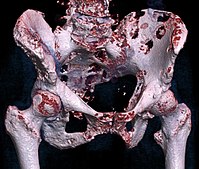
Photo from wikipedia
AIM To investigate the imaging features of chondrosarcoma of the temporomandibular joint (TMJ) and review the literature. MATERIALS AND METHODS Computed tomography (CT), magnetic resonance imaging (MRI), and integrated positron-emission… Click to show full abstract
AIM To investigate the imaging features of chondrosarcoma of the temporomandibular joint (TMJ) and review the literature. MATERIALS AND METHODS Computed tomography (CT), magnetic resonance imaging (MRI), and integrated positron-emission tomography (PET)/CT images of nine patients with histopathologically confirmed chondrosarcoma of the TMJ were reviewed retrospectively. Imaging features regarding the direction of lesion growth, bone destruction, infiltration into the tendon of the lateral pterygoid muscle (LPM) in the pterygoid fovea, enhancement pattern, calcification, periosteal reaction, markedly hyperintense T2 signal area, and qualitative PET signal intensity were evaluated. RESULTS Seven of nine patients (77.8%) presented with lesion growth that was outward from the medulla of the mandibular condyle. Infiltration into the tendon of LPM in the pterygoid fovea was observed in all cases, and 77.8% (7/9) of them demonstrated >50% infiltration. All the lesions showed a mixed peripheral and internal enhancement, and revealed a markedly hyperintense T2 signal intensity area, which showed no enhancement. Although five of nine cases demonstrated higher FDG uptake compared with that of the liver, the other four cases showed less FDG uptake than that of the liver. CONCLUSION Chondrosarcoma of the TMJ demonstrated several imaging features, including outward growth from the mandibular condyle, resultant infiltration into the tendon of LPM in the pterygoid fovea, various patterns of internal enhancement, and a markedly hyperintense T2 signal intensity area. These imaging features may be helpful to differentiate chondrosarcoma from other lesions of the TMJ.
Journal Title: Clinical radiology
Year Published: 2020
Link to full text (if available)
Share on Social Media: Sign Up to like & get
recommendations!